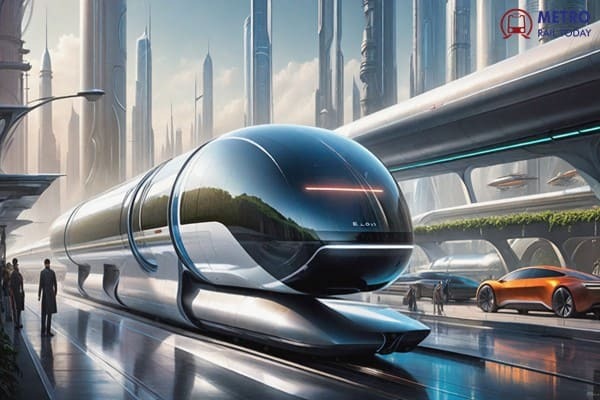Hyperloop technology, first proposed by entrepreneur Elon Musk in 2013, envisions a revolutionary mode of transportation where passenger or cargo pods travel through low-pressure tubes at near-supersonic speeds. This concept aims to significantly reduce travel times over medium-range distances, potentially transforming the landscape of intercity travel.
How Does Hyperloop Work? 🛠️
The Hyperloop system consists of three primary components: tubes, pods, and terminals.
-
Tubes: Large, sealed, low-pressure environments that minimize air resistance, allowing for higher speeds
-
Pods: Pressurized capsules that levitate on a near-frictionless magnetic field within the tubes. This levitation is achieved through magnetic levitation (maglev) technology, similar to that used in some high-speed trains.
-
Propulsion: Electric propulsion systems accelerate and decelerate the pods, with linear induction motors placed at intervals along the tube.
By combining these elements, Hyperloop aims to achieve speeds exceeding 1,000 km/h (620 mph), drastically cutting travel times between major cities.
Advantages of Hyperloop Over Traditional Trains 🚄
-
Speed: Hyperloop’s projected speeds are significantly higher than those of conventional high-speed trains. For instance, while the fastest trains operate around 320 km/h (200 mph), Hyperloop could potentially reach speeds over 1,000 km/h, reducing a journey that takes several hours by train to mere minutes.
-
Energy Efficiency: The low-pressure environment reduces aerodynamic drag, allowing pods to glide with minimal energy consumption. Additionally, the use of magnetic levitation eliminates friction between the pod and the track, further enhancing efficiency.
-
Weather Resistance: Enclosed tubes protect the system from adverse weather conditions, ensuring consistent and reliable operation.
-
Reduced Land Footprint: Elevated tubes can be constructed above existing infrastructure, minimizing the need for extensive land acquisition and reducing environmental disruption.
Challenges and Disadvantages of Hyperloop ⚠️
Despite its promising advantages, Hyperloop faces several significant challenges:
-
High Initial Investment: The construction of the infrastructure, including vacuum tubes and maglev systems, requires substantial financial investment. Estimates suggest that the costs could be prohibitively high, potentially exceeding those of traditional high-speed rail projects.
-
Technical Complexity: Maintaining a near-vacuum environment over long distances presents significant engineering challenges. Ensuring the structural integrity of the tubes and managing the thermal expansion and contraction are complex tasks.
-
Safety Concerns: The high speeds and enclosed nature of the system raise questions about passenger safety in the event of emergencies, such as power failures or structural breaches.
-
Land Acquisition and Regulatory Hurdles: Securing the necessary land rights and navigating the regulatory landscape can be time-consuming and challenging, potentially delaying project timelines.
-
Passenger Comfort: Traveling at near-supersonic speeds in a confined tube may lead to discomfort due to rapid acceleration and potential vibration. Ensuring a comfortable passenger experience is crucial for widespread adoption.
Current Developments and Future Prospects 🚧
Several companies and countries are actively exploring Hyperloop technology:
-
Virgin Hyperloop: Achieved a significant milestone in November 2020 by conducting the first passenger test, reaching speeds of 172 km/h (107 mph) on a 500-meter track.
-
India’s Initiative: The Indian government is collaborating with the Indian Institute of Technology Madras to develop a Hyperloop system capable of speeds between 700 and 1,200 km/h (435 to 745 mph). Initial tests are underway, with the aim of revolutionizing transportation within the country.
-
European Efforts: The European Hyperloop Centre in the Netherlands is conducting tests to evaluate the feasibility of the technology, with a focus on integrating it into the existing transportation network.
Can Hyperloop Replace Trains? 🤔
While Hyperloop presents an innovative approach to high-speed transportation, whether it can replace traditional trains depends on various factors:
-
Distance and Demand: Hyperloop is most effective for medium-range distances (up to 1,500 km or 930 miles). For shorter distances, traditional trains may remain more practical due to lower costs and established infrastructure.
-
Cost-Benefit Analysis: The high initial investment and maintenance costs of Hyperloop systems must be weighed against the potential economic benefits and time savings.
-
Public Acceptance: Gaining public trust and acceptance is crucial. Concerns about safety, comfort, and environmental impact need to be addressed transparently.
In conclusion, while Hyperloop has the potential to complement and, in certain scenarios, replace traditional trains, its widespread adoption faces significant hurdles. A hybrid transportation network that integrates Hyperloop with existing rail systems may offer the most practical and efficient solution for future intercity travel.


